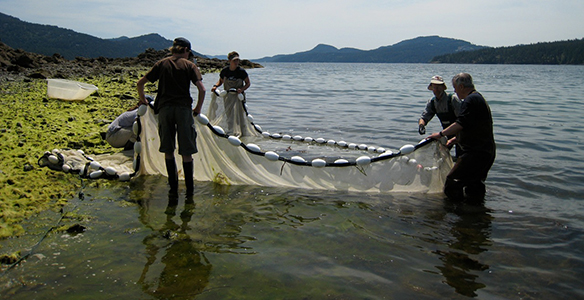||| FROM JANET ALDERTON |||
I understand that trying to fulfill this docket request would consume vast amounts of staff time and attention, if the goal is to get as close to a perfect analysis as possible. It has been said that the perfect is the enemy of the good. I do not think an exact analysis is required. The U.S. Census is never exact. But its ballpark results are still useful. I think the highest purpose of Joe Symons’ request is to prod the bear slumbering in its den. The bear has been slumbering comfortably for many decades. It is time for the bear to wake up, lumber outside, and survey its domain.
Has anything changed? Is San Juan County still a sleepy country county that is “different” from all other counties? Can people pretty much do as they wish, and it will not really matter?
Having nudged the sleepy bear persistently enough, it clambers out of its den and looks around. It notices that we are being affected by Market Forces that have created a severe lack of housing for both low and moderate income residents.
The wise bear asks itself, “Will doing more of what got us here in the first place provide the housing our communities need to support the services and amenities that we all demand? My tummy is growling, but all the restaurants are packed with people waiting to be served by over-worked staff who have no decent place to sleep.” The bear wonders, “Are we running up against resource limits? I am very, very thirsty.”
If our population doubles or triples -or worse, will we have enough water resources? Does it make sense to continue granting docket requests that change a land use designation from Forest Resource to Rural Farm Forest when the number of residences permitted will increase from one to eight each time this is granted? Why increase the number of potential residences when no shortage of developable parcels exists (our ballpark buildout capacity is more than three times our current population.)
The bear wonders, “Might we be running up against transportation limits? In the old days, I really enjoyed the occasional ferry ride.”
The Growth Management Act requires that transportation infrastructure be adequate to meet the projected growth. The ferries are failing now. And our funding system for ferry staffing, operations, maintenance, and replacement is not up to the task. Just beginning to turn these deficiencies around will take at least 10 years. In the meantime, things will likely get much worse. This might be enough to make the bear shake its head and decide to clamber back inside its den.
In this context, where the “baked in” ballpark buildout exceeds three times our current population, why grant Docket Requests that change a land use designation from Forest Resource to Rural Farm Forest? The residence number goes from one to potentially eight. We are not lacking buildable parcels in San Juan County. I know that I mentioned this earlier, but it “bears” special consideration because of the ferry limitations.
There is no question that we are lacking resources such as ferry capacity and affordable housing. We could well be losing ground on water resources as our climate warms and our rainfall patterns change. Adequate water is required by the GMA for current and projected growth. Growth will only increase water demands. Stating that we can meet our future needs with desalination is not a responsible approach. Desalination is energy-intensive and creates concentrated salt waste.
We should have learned in our ever more polluted world that “dilution is NOT the solution.” Trucking water to supply new residences is also a truly misguided idea. Our islands are water limited, and trucking water over large distances uses energy and burns fossil fuels. I know of no electric water trucks.
A well-educated bear emerging from hibernation might ask her/himself, “Are we affected by the laws of physics? Does water run downhill — especially on impervious surfaces?” An earlier County Council was not amused when I brought a cookie sheet, a container of water, and a towel to demonstrate that water does run downhill over impervious surfaces in San Juan County. The topic was the infiltration rate of stormwater flowing over barren rocky shorelines compared to shorelines with abundant native trees and shrubs.
I am very happy that more attention is being given to stormwater handling, but I think that we should also be requiring that less impervious surfaces be created in the first place.
More development creates more impervious surfaces = greater amounts of stormwater runoff = faster and greater potential damage during intense storms.
“Mitigation” is a minimalist approach that does not truly compensate for the destruction of wetlands, shoreline trees and native shrubs, upland forests, shrublands, and grasslands -all of which currently capture rainfall and permit it to infiltrate the soil. “Mitigations” are especially ineffectual in San Juan County because, for example, mitigation plantings are theoretically monitored for a few years (3 years?). For our overworked county staff, this might slide to the bottom of the “must do” list.
As storm events become more intense, development and its impervious surfaces have become ever greater generators of stormwater. The necessity of increasing the overall stormwater infiltration capacity has become obvious.
Maybe less obvious is the need to reduce the rate of creation of impervious surfaces. This is something that can be done in San Juan County. Pervious paving can be used, living roofs can be incentivized, rainwater catchment and reuse can be incentivized, rain gardens can be required, etc. Building footprints could also be reduced. Houses have grown ever larger as families have grown ever smaller.
In addition to preventing flooding, these measures allow water to infiltrate into the ground and recharge our essential aquifers.
In the conversation below, Alice C. Hill observes:
“But, unfortunately, we have built all of our structures, made our land use choices on the assumption that the past will resemble the future. “
Let us not remain hibernating and continue forward as if nothing has changed or will change. Nudge that bear until it truly awakens, emerges from its den, and surveys its domain with wise eyes that look towards the future of our children and our grandchildren and all life on planet earth.
Extreme Weather Takes Many By Surprise

Alice C. Hill was on the National Security Council under President Obama where she led the development of national policy to counter the catastrophic risks of climate change. Her new book is The Fight For Climate After Covid-19:
“The threat is very serious. Many call it dire. We will see more extreme events for the foreseeable future, and, unfortunately, we are not prepared. I see communities constantly surprised by the severity of these events, although the science has told us that this is coming, and it’s coming actually more quickly than originally anticipated.
“But, unfortunately, we have built all of our structures, made our land use choices on the assumption that the past will resemble the future. Climate Change upends that assumption. And our infrastructure fails as a result.
“We now see 4 to 5 times more extreme events than we did in the 1970s.”









Bravo Janet! We gotta keep tweaking that bear into looking with new eyes!
“If it’s predictable, it’s preventable.” That’s why we call it “change”. Desalination will be the culmination of decades of our elected leaders failed economic policies. Environmental and social well-being indices are base-line criteria for what’s needed to measure the impacts of growth with… not how much money can we continue to make.
“These events tell us we’re not prepared,” said Alice Hill, who oversaw planning for climate risks on the National Security Council during the Obama administration. “We have built our cities, our communities, to a climate that no longer exists.”
From today’s NYTs– Climate and health: An editorial published in more than 200 medical and health journals worldwide, declared a 1.5-degree-Celsius rise in global temperatures was the “greatest threat to global public health.”
Thank you, Janet, for reminding us of the perils of unregulated growth. If we learned anything from this past summer season, it’s that our ferries are ALREADY at their limit. And that’s not going to improve for at least ten years, according to a person I know who worked on the ferries for decades and currently serves on their citizen’s advisory committee. Our restaurants are at their limit, unable to hire enough workers because of the lack of affordable rentals in the summer.
What’s next, our water supplies? Desalination and trucking it in (yes, on the ferries!) are the “wet dreams” of fools. We have to make do with what falls on our lands and can be stored or absorbed in them. Nature has its limits, and we are ultimately part of nature.